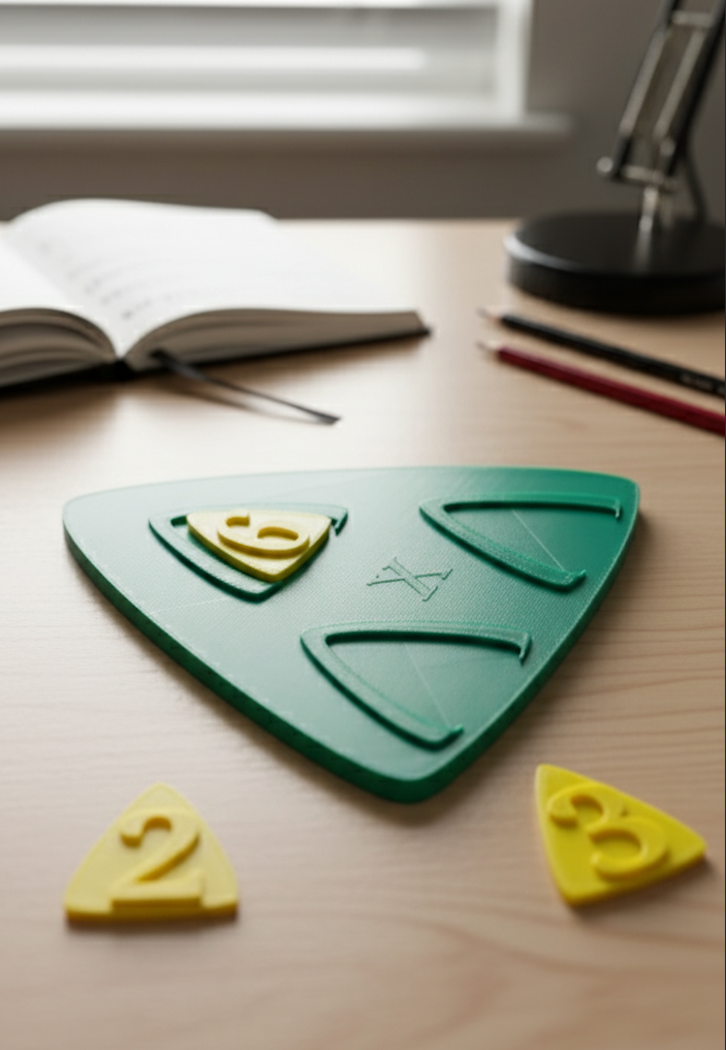Your cart is currently empty!

My First 3D Design: The One-Hour Coffee Break That Changed Everything
Before I could ask teachers to learn 3D design, I needed to prove it was actually possible.
So I opened Tinkercad during my coffee break with zero design experience and one goal: create something a teacher could use tomorrow.
The Challenge: A Real Classroom Need
The opportunity presented itself unexpectedly. I was observing a multiplication lesson at Green School when the head of primary mentioned she was planning to purchase a trifacta – a triangular teaching tool that helps students visualize multiplication relationships.
For those unfamiliar, a trifacta is a clever hands-on learning tool shaped like a triangle. It has three sections where numbers relate to each other through multiplication (and division, addition, subtraction). Students can manipulate it to see how numbers connect, making abstract mathematical concepts tangible.
The head of primary had found a commercial version to buy. But hearing this, a question formed in my mind: Could we make this ourselves? And more importantly, could I design it?
This wasn’t just about saving money, though that mattered. It was about testing the very premise of what we were trying to build. If 3D printing in education was going to work, teachers would need to create their own resources. Before I could ask that of them, I needed to prove it was actually doable.
A Coffee Break Design Session
I opened Tinkercad during a coffee break in our office. My colleagues were around, chatting, doing their own work. I had never used 3D design software before. I had no training, no tutorial pulled up, just the tool and a goal.
The interface was surprisingly intuitive. Drag shapes. Resize them. Combine them. Delete what doesn’t work.
The biggest challenge wasn’t the software – it was getting the proportions right. The triangle needed to be large enough to hold numbers clearly, but small enough to be practical. The parts needed to fit together properly. The thickness had to be sturdy but not wasteful of material.
About an hour later, I had it. A complete trifacta design, ready to print.
My colleagues couldn’t believe I’d made it. There was genuine amazement in their reactions. This person who’d been hesitant about entering the 3D printing business just an hour ago had created an actual educational tool.
The Magic of the First Print
Watching that first print was extraordinary.
Layer by layer, something I had designed on a screen was becoming real. Physical. Tangible. The printer hummed along, and with each passing minute, my design took shape.
When it finished and I held it in my hands, I understood something profound: This was the feeling we wanted to give students. This was why 3D printing mattered in education.
The trifacta worked perfectly on the first try. Yes, I could see design improvements I wanted to make – ways to make it more visually appealing, small refinements to the geometry. But it functioned exactly as intended. A teacher could use this tomorrow.
And here’s the remarkable part: my printed version cost 2-3 times less than the commercial one the school was planning to purchase.
The Moment Everything Clicked
I showed that trifacta to everyone. Teachers. Friends. Family members. My own children, who are also involved in this business now. The response was unanimous: this was valuable.
To this day, I show that first design in our training sessions. Not because it’s perfect – it isn’t. But because it represents something crucial: proof that you don’t need to be an expert to create something meaningful.
All those hours I’d spent researching 3D printing in education, all that reading and learning while still hesitant about the business – it had been worth it. This one hour over coffee had validated everything.
What This Means for Education
If I could design a functional educational tool in an hour with zero experience, what could an experienced teacher create? Someone who intimately understands their subject, who knows exactly what their students struggle with, who sees gaps in available resources every single day?
That’s the real power of 3D printing in education. Not buying expensive equipment to print other people’s designs, but empowering educators to solve their own classroom challenges.
The trifacta wasn’t just my first 3D design. It was proof of concept for our entire approach.

Leave a Reply